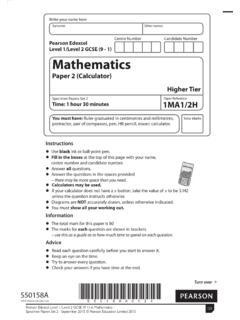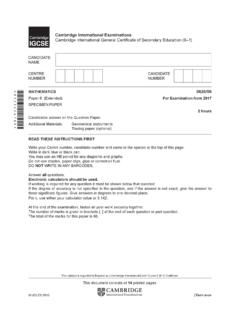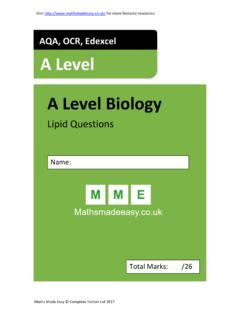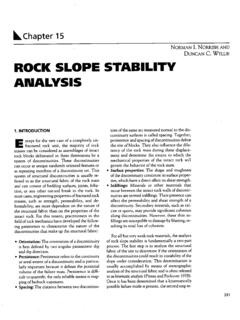Transcription of GCSE Geography Paper 1 Living with the physical ...
1 This draft qualification has not yet been accredited by Ofqual. It is published to enable teachers to have early sight of our proposed approach to GCSE Geography . Further changes may be required and no assurance can be given that this proposed qualification will be made available in its current form, or that it will be accredited in time for first teaching in September 2016 and first award in August 2018. SPECIMEN ASSESSMENT MATERIAL GCSE Geography Paper 1 Living with the physical environment Specimen Time allowed: 1 hour 30 minutes Materials For this Paper you must have: a pencil a ruler. Instructions Use black ink or black ball-point pen. Fill in the boxes at the bottom of this page. Answer all questions in Section A and Section B.
2 Answer two questions in Section C. You must answer the questions in the spaces provided. Do not write outside the box around each page or on blank pages. Do all rough work in this book. Cross through any work you do not want to be marked. Information The marks for questions are shown in brackets. The total number of marks available for this Paper is 88. Spelling, punctuation, grammar and specialist terminology will be assessed in Question Advice For the multiple-choice questions, completely fill in the circle alongside the appropriate answer(s). If you want to change your answer you must cross out your original answer as shown. If you wish to return to an answer previously crossed out, ring the answer you now wish to select as shown.
3 Please write clearly, in block capitals, to allow character computer recognition. Centre number Candidate number Surname Forename(s) Candidate signature CORRECT METHOD WRONG METHODS 2 Version Section A The challenge of natural hazards Answer all questions in this section. Question 1 The challenge of natural hazards Study Figure 1, a graph showing changes in the amount of carbon dioxide (CO2) in the atmosphere. Figure 1 3 Version Turn over Describe the change in the amount of carbon dioxide in the atmosphere shown in Figure 1. [2 marks] Outline one reason why the concentration of carbon dioxide in the atmosphere has changed over time. [2 marks] Question 1 continues on the next page 0 1.
4 1 0 1 . 2 4 Version Study Figure 2, a map showing how global surface temperatures might change by 2070. Figure 2 Using Figure 2, which two of the following statements are true? Shade two circles only. A Changes in temperature are likely to be lowest in equatorial areas. B Temperatures in Asia are likely to rise by 1 C. C Temperatures over most of the sea areas north of 60 N are expected to increase by 4 C. D Temperatures over the whole of Africa are likely to rise by 3 C or 4 C. E The central parts of the continents are expected to have the lowest rise in temperature. F The rise in sea temperatures is likely to be greatest south of the equator. [2 marks] 0 1 . 3 5 Version Turn over The weather of the UK is becoming more extreme.
5 Use evidence to support this statement. [6 marks] Question 1 continues on the next page 0 1 . 4 6 Version Study Figure 3, a world map showing the tracks and strengths of tropical storms. Figure 3 0 1 . 5 Complete the following sentences. [2 marks] The greatest number of category four tropical storms happen in the .. Ocean. Apart from very strong winds, one other associated weather feature of a category four storm is .. Give one condition that is needed for a tropical storm to form. [1 mark] 0 1 . 6 7 Version Turn over Study Figure 4, a satellite image of Hurricane Katrina shortly before it crossed New Orleans in the USA. Figure 4 Using Figure 4 only, forecast the weather conditions in New Orleans over the next 24 hours.
6 [4 marks] Question 1 continues on the next page 0 1 . 7 8 Version Give two reasons why tropical storms eventually lose their energy. [2 marks] Reason 1: Reason 2: Question 1 continues on page 10 0 1 . 8 9 Version Turn over Question 1 continues on the next page DO NOT WRITE ON THIS PAGE ANSWER IN THE SPACES PROVIDED 10 Version Study Figure 5a, a photograph showing an area affected by an earthquake in 2010, and Figure 5b, a photograph showing an area affected by a volcanic eruption in 2006. Figure 5a Figure 5b 11 Version Turn over Choose either an earthquake or a volcanic eruption. Assess the extent to which primary effects are more significant than secondary effects.
7 Use Figure 5a or 5b and an example you have studied. [9 marks] [+ 3 SPaG marks] Chosen tectonic hazard: End of Section A Turn over for Section B 0 1 . 9 12 Version Section B The Living world Answer all questions in this section. Question 2 The Living world Study Figure 6, a world map showing some large scale global ecosystems. Figure 6 Using Figure 6, which one of the following statements is correct? Shade one circle only. A Most areas of tundra are found on the edges of land masses. B The largest polar area is found north of the equator. C There are no areas of tundra south of the equator. D There are no polar areas south of the Tropic of Capricorn. [1 mark] 0 2 . 1 13 Version Turn over Describe the distribution of hot deserts shown in Figure 6.
8 [2 marks] Which one of the following statements describes the climate of a tropical rainforest? Shade one circle only. A Mild temperatures (10 18 C), rainfall all year (approximately 1000 mm) B High temperatures all year (over 30 C), very dry (250 mm of rainfall per year) C High temperatures all year (25 27 C), rainfall in every month (1800 2000 mm per year) D Wide range of temperatures (15 30 C), seasonal rainfall (approximately 750 mm) [1 mark] Question 2 continues on the next page 0 2 2 0 2 . 3 14 Version Study Figure 7, a photograph showing part of the tropical rainforest in Central Africa. Figure 7 15 Version Turn over Describe and explain the features of the vegetation shown in Figure 7.
9 [6 marks] Question 2 continues on the next page 0 2 . 4 16 Version Study Figure 8, which shows how the forested regions of the world changed between 2005 and 2009. Figure 8 Which region of the world had the greatest rate of deforestation between 2005 and 2009? [1 mark] 0 2 . 5 17 Version Turn over State the number of regions of the world where the rate of deforestation was greater than the world average rate of deforestation between 2005 and 2009. [1 mark] Outline one possible environmental impact of deforestation. [2 marks] Suggest one way that international co-operation can help make tropical rainforests more sustainable. [2 marks] Question 2 continues on the next page 0 2.
10 7 0 2 . 8 0 2 . 6 18 Version For a hot desert environment or cold environment you have studied, to what extent does that environment provide both opportunities and challenges for development? [9 marks] Chosen environment: End of Section B 0 2 . 9 19 Version Turn over Turn over for Section C DO NOT WRITE ON THIS PAGE ANSWER IN THE SPACES PROVIDED 20 Version Section C physical landscapes in the UK Answer two questions from the following: Question 3 (Coasts), Question 4 (Rivers), Question 5 (Glacial). Shade the circle below to indicate which two optional questions you will answer. Question 0 3 Question 0 4 Question 0 5 Question 3 Coastal landscapes in the UK Study Figure 9, on the insert, a 1: 50 000 Ordnance Survey map extract of part of the coast of south west England.










